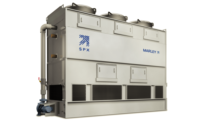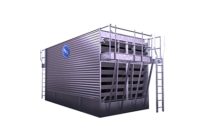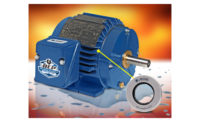Maximizing cooling tower technology for HVAC, power, industrial applications

Recent developments in factory-assembled cooling tower technology can increase cooling capacity per cell by up to 50%, expanding the applications for so called “package” towers supporting HVAC and industrial processes. Although field-erected towers have long been the preferred product for process cooling in power plants and heavy industry, new robust designs and materials coupled with cost-saving building techniques now make a new generation of modular products logical alternatives for a broader range of applications.
For example, an advanced design factory-assembled cooling tower can be delivered with 60% shorter lead time and installed in about 20% of the time it would take to build a traditional field-erected cooling tower. With simplified piping and electrical wiring, more flexible site placement and no costly concrete basin construction required, the cost benefits of advanced factory-assembled towers become more clear.
Reducing energy and installation costs for HVAC applications
In HVAC applications, energy efficiency is a major driver for end users who are increasingly focused on building system technologies that reduce energy consumption. Increased cooling capacity per cell means fewer cells, less piping and fewer electrical connections are required, saving labor and material costs.
Reducing field-erection costs for power and heavy industrial applications
A major concern for large power and heavy industrial projects is the cost of cooling tower construction. Tower components are typically shipped to the site over a period of weeks, as the building process advances. It can take 20 weeks or more for components on a typical field-erected project to arrive on site. The process involves large labor forces and expansive staging areas, which contribute to high construction costs. Complex industrial projects also heighten health and safety concerns and weather issues can impact completion.
Alternately, pre-assembled cooling tower modules are built in a controlled factory environment and shipped in 6-8 weeks. The modules are assembled on site in about 20% of the time required for a field-erected tower. The modular design and field assembly process reduce on-site labor, work duration and staging area requirements and contribute to a safer work environment.
The shorter delivery and construction times of a pre-assembled tower offer power and industrial customers a distinct advantage because meeting capacity requirements and managing downtime and outages are of critical concern to their operations.
For example, a recent construction estimate to replace a field-erected cooling tower in the southeast United States required 4,500 hours and 7 weeks of field labor. When a modular pre-assembled tower was specified, installation duration was reduced to less than 2 weeks – an enormous savings in time as well as plant operational efficiency. And, the plant’s additional costs for temporary cooling were eliminated.
Building a field-erected cooling tower requires construction of a foundation in the form of a concrete cold water basin. The cost of this basin alone typically adds 40% to the tower construction costs. A factory-assembled tower includes an integral basin, which eliminates this additional construction cost. The basin is assembled and leak-tested in the factory.
On-site testing of field-erected towers is often required to verify they meet the specified cooling capacity. Conducted by independent third-party agencies, the tests typically cost about $25,000. These additional expenses are eliminated with factory-assembled towers, which should be certified by the Cooling Technology Institute, Houston, Texas, to meet thermal performance as specified.
Design advantages of new cooling tower design
Cooling towers are typically designed to meet summer cooling demand. Crossflow design also inherently shields cold water basins from sun exposure, discouraging algae growth. In cold weather, crossflow design helps prevent high winds from causing water escape, which can lead to icing and safety concerns.
Whether designing a new cooling system or replacing an aging traditional cooling tower, a crossflow pre-assembled cooling tower design merits careful consideration for HVAC, power generation and heavy industrial cooling applications.
Looking for a reprint of this article?
From high-res PDFs to custom plaques, order your copy today!





